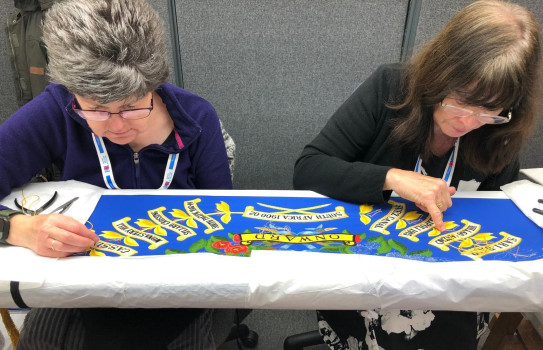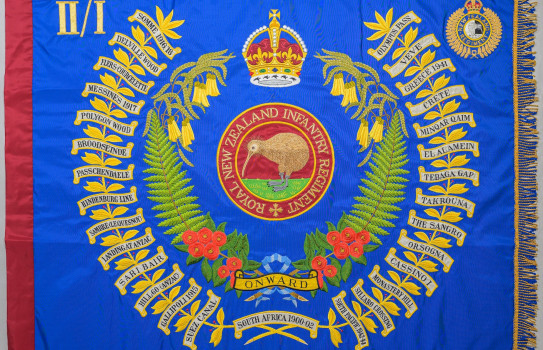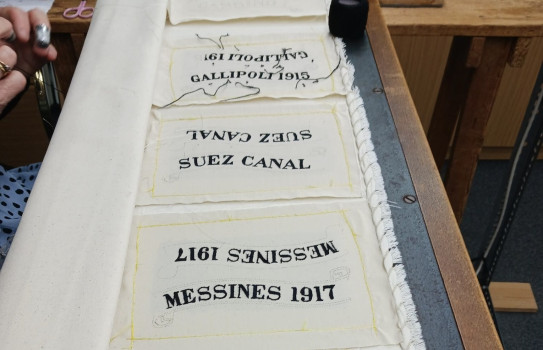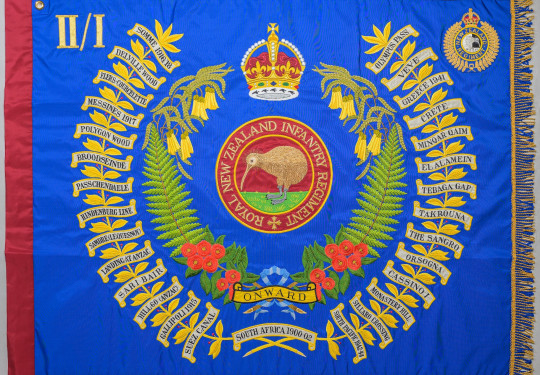Behind the stitch of the NZ Army’s new King’s and Regimental Colours
In a special ceremony last week the new King’s and Regimental Colours of the New Zealand Army’s 2nd/1st Battalion, Royal New Zealand Infantry Regiment (2/1 RNZIR) were consecrated at Burnham Military Camp.
05 November, 2024
They were presented to the Battalion by Her Excellency, The Rt Hon Dame Cindy Kiro, GNZM, QSO, Governor-General of New Zealand, on behalf of His Majesty King Charles III, and marked the culmination of a significant new chapter for 2/1 RNZIR.
The backstory of the Colours (hand-embroidered ceremonial flags) is also remarkable, and one steeped in history.
2/1 RNIZR’s two new Colours were hand stitched by three women from Wyedean Weaving in Yorkshire in the United Kingdom. 2/1 RNZIR’s Colours are the first in New Zealand to be updated with the King’s insignia.
Aileen Henderson, Wendy Hatton and Susan Jones collectively have close to 120 years’ experience in perfecting the intricate embroidery of military history around the world.
Ms Henderson says the process of creating Colours can only begin after the designs have been submitted to The King for approval.
“We can only start production once we receive this approval. I have an exceptional memory for patterns we’d previously created for Hobsons, the previous supplier of Colours before Wyedean, and can identify if we already have them on file,” patternmaker Ms Henderson said.
“If we don’t, new patterns are developed. Following the recent change in the monarchy, new patterns have been required to incorporate the King’s crown.”

Susan Jones, left, and Wendy Hatton working on the 2/1 RNZIR Colours in Yorkshire before they were collected and brought back to New Zealand for last week’s ceremony
The craftsmanship of 2/1 RNZIR’s new King’s and Regimental Colours took more than 900 hours of meticulous embroidery.
“We utilised three metres of pure silk cloth, 75 grams of gold thread and 150g of pure silk embroidery thread,” embroiderer Wendy Hatton says.
“The highlight of this project was working with the distinctly different design compared to our usual Colours, particularly the vibrant colours set against the dark blue silk background, which added unique visual appeal.”
Working on this project carried additional significance for both Ms Hatton and Ms Jones who had previously worked on the embroidery of the Royal New Zealand Air Force’s King’s Colour (formerly a Queen’s Colour), which was presented by then Prince Charles in 2019.
We feel an immense sense of pride and honour in contributing to such significant pieces of history for militaries around the globe ~ Ms Susan Jones

The new Regimental Colour of 2nd/1st Battalion, Royal New Zealand Infantry Regiment, emblazoned with eight additional battle honours
The new King’s Colour of 2nd/1st Battalion, Royal New Zealand Infantry Regiment

Stitching the battle honours for the Regimental Colour of 2/1 RNZIR
The previous 2/1 RNZIR King’s and Regimental Colours were presented to the unit in 1980 and after more than 44 years of general wear and tear they had reached end of life.
When Colours are replaced the old ones are laid up, which typically sees them hung in a church or chapel associated with the regiment, although some particularly significant Colours may be displayed in cathedrals, or other public buildings such as museums.
“We take great pride in seeing the old Colours laid up in Westminster and other churches, especially when our families ask which ones we created,” Ms Henderson said.
Read more
Click here(external link) to dive into the journey of the new King’s and Regimental Colours.
